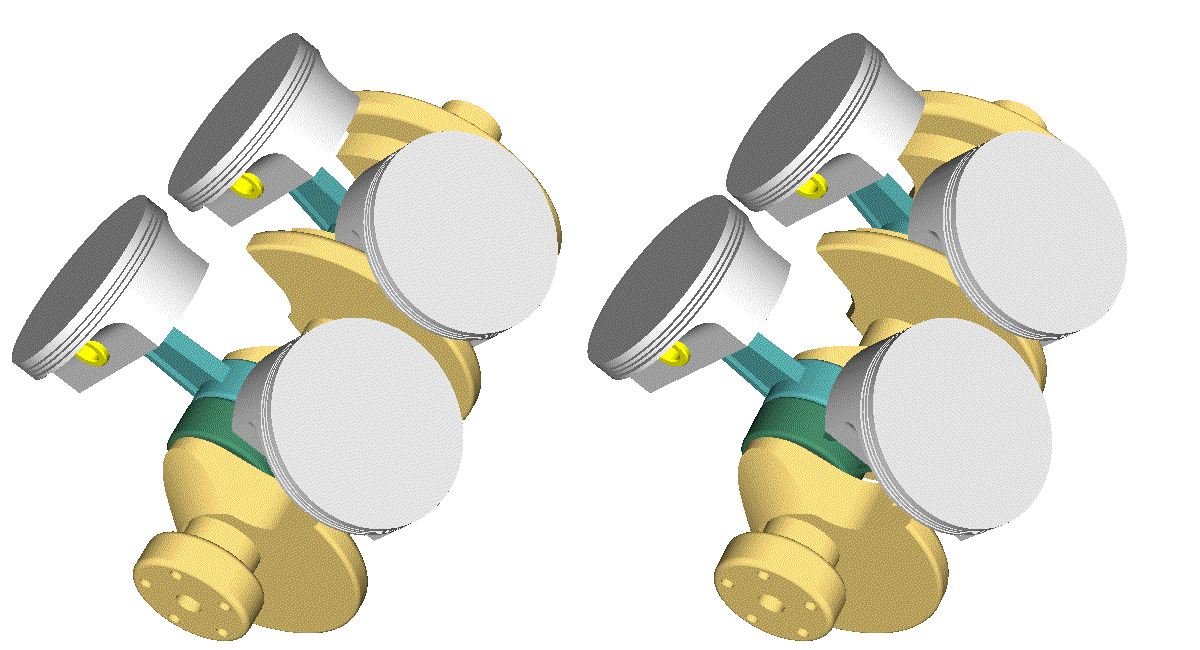Hello Tommy Cookers.
You write:
“your 'short stroke' In-Line Four illustrated in your post at 4.44 yesterday .......
would to me apparently generate extremely large vibrations at engine frequency
(unless equipped with some unusually capable counterbalance shaft/s that you didn't show)”
You are right.
The I-4 with the crankpins arranged at 0, 90, 90 and 0 degrees around the crankshaft rotation axis (i.e. the PatRoVa in the animation) has an unbalanced inertia force (1st order, rotating).
Similarly the I-4 with the crankpins arranged at 0, 90, 270 and 180 degrees around the crankshaft rotation axis (i.e. the Yamaha M1 and R1) has an unbalanced inertia moment (1st order, rotating).
I know Yamaha R1 does use a balance shaft (counter-rotating at crankshaft speed) having two balance webs arranges 180 degrees from each other.
Does anybody know if Yamaha M1 (the racing engine in MotoGP) uses a counter-rotating balance shaft?
Or Yamaha prefers the vibrations from adding a balance shaft, and the synchronization gearing it requires, in a racing engine?
The PatRoVa I-4 of the animation requires either a counter-rotating balance web at the middle of the crankshaft, or a pair of balance webs symmetrically located relative to the center of the crankshaft. For normal use.
For racing use the need of external balance webs is questionable.
In order to avoid the external balance webs (of the Yamaha crossplane-crankshaft I-4 and of the I-4 PatRoVa of the animation), a better choice is the V-4 arrangement with the crankpins arranged at 0, 0, 90 and 90 degrees:

(used by some Ducati V-4 in the moto-GP).
You also write:
“and with your Cross Radial PatATeco .....
again, I wonder, have you evaluated the likely detriment to crankshaft/propellor shaft torsional vibration when driving a propellor or rotor ?
complicated by and strongly related to reduction gearing factors (if reduction gearing is used)
there are very many precedents of crankshaft redesign due to this, not all conveniently in the distant past
eg the RR 1970s development of Continental's flat 4 (direct drive of course) to 130 hp for the Aerobat version of the French-built Cessna 150
had fatigue failures in service and was effectively banned, without iirc compensation to customers
the props were disappearing in flight
many other efforts by lesser organisations have similarly failed since”
Here is a UL-power crankshaft for a flat four aircraft engine:

Single piece, big diameter of journals / crankpins. It seems strong.
And here it is shown the crankshaft of a Hercules 14-cylinder double-row Radial:

The crankshaft is “a built-up three-piece unit which allows the use of solid master connecting rods”. It seems not adequately strong, however it deals with several times more power than the crankshaft of the flat-4.
In a flat-4 engine, all the four pistons stop together (at BDC and TDC), which means zero kinetic energy. And 90 degrees later (middle stroke) they all move at high speed, which means they, as a set, have a big amount of kinetic energy. As in all even firing 4-stroke four-cylinder engines, the heavy second-order inertia torque requires strong / heavy crankshaft structure.
If a heavy propeller is secured at the one end of the crankshaft, then the propeller has to accelerate / decelerate twice per crankshaft rotation in order to absorb and then give back the kinetic energy required by the set of the four pistons.
In the PatATeco Cross-Radial of the animation, the total kinetic energy of the four pistons is constant (about zero inertia torque). The propeller can be secured on the crankshaft without any issue.
Things are better than in the conventional Radials because the motion of all pistons is the same and because there is no master rod (you can read more at
http://www.pattakon.com/pattakonPatAT.htm ).
It is hard to believe, however a four-cylinder PatATeco is better balanced than the double row 18-cylinder Centaurus Sleeve-Valve Radial of Bristol.
Another advantage of the PatATeco Cross-Radial is that it is a two-stroke engine.
A combustion happens every 90 crank degrees.
The successive power pulses overlap as in the even firing V-8 (smooth delivery of power).
The pistons around their TDC run always under heavy pressure (compare to the pistons of the four-strokes when they pass from their combustion-TDC, and when, 360 crank degrees later, they pass from their overlap-TDC).
When I compare the PatATeco Cross-Radial with a flat-four airplane engine (like, say, the Rotax 912 or the UL-260i of UL-power) what I see is a more reliable engine (no valves, no valve springs, no camshafts, no push-rods, no rocker-arms etc), a way more lightweight engine (one crankpin serves all the four pistons), a better cooled engine (air-cooled; read at UL-Power how proud they are for their aircooling, even if the two cylinders are necessarily arranged behind the other two cylinders), an engine with better fuel efficiency (less friction, better shape of combustion chamber), etc.
So, take another look at the PatATeco and let me know where you see problems.
Thanks
Manolis Pattakos



